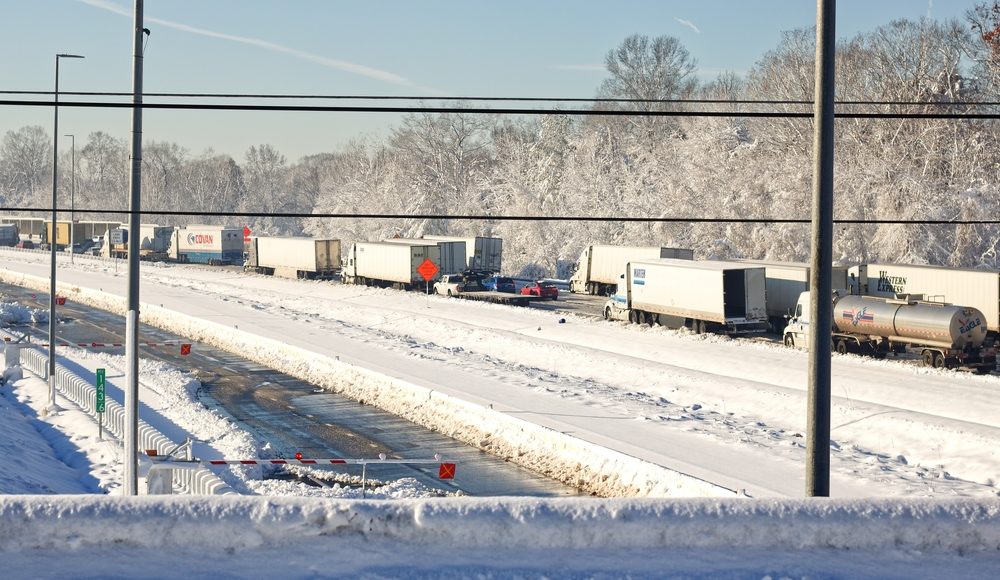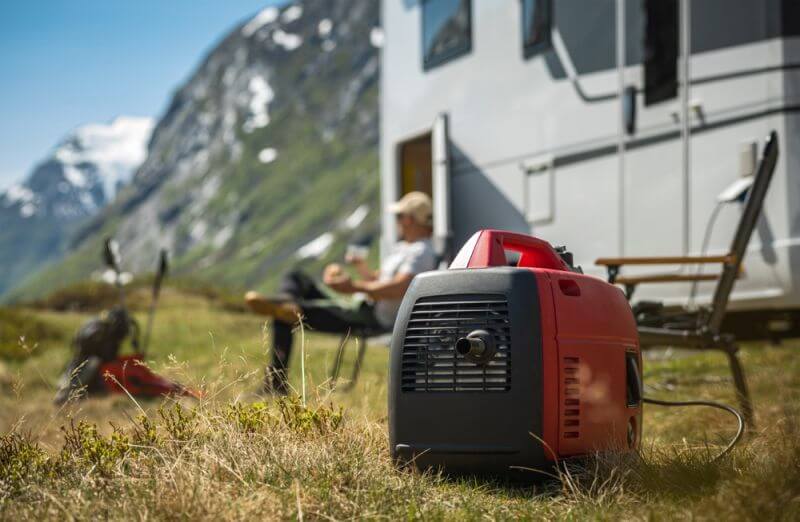Everyone has heard about the massive, 50-mile long traffic jam that started the year on I-95 in Virginia. Eleven inches of snow, falling on already icy roads, produced dangerous conditions, causing several tractor-trailer rigs to jackknife. While such occurrences aren’t all that uncommon, the combination of weather and road conditions made it extremely difficult to clear the roads. Some travelers were stranded in their cars, in freezing conditions, for 24 hours, waiting for the road to clear. The more fortunate managed to get out in about 16 hours.
A critical point about these people who were stuck on I-95; the majority of them were commuters on their way home from work. So they were people who knew the highway and should have known how inclement weather affected it. Not only that, but they should have known what services would be available alongside the road, as well as what exits there were and where those exits went.
None of us can control the weather or what others do in inclement weather. But we have complete control over what we do about it. Expecting others to take care of us in such situations is unreasonable. Yet, many of those stranded motorists complained that the police didn’t send officers to walk down the 50 miles of traffic, telling people what was going on. I’m sure that whatever officers were on shift for that section of road were busy just trying to clear the situation and keep it from getting worse.
By keeping it from getting worse, I mean blocking off the highway and routing drivers to alternate routes. That’s standard practice for the police in such situations. Everyone complains when they do it, but that’s much better than being trapped in your car overnight.
Of course, situations like this one aren’t the only ones in which one might end up caught in their car overnight. Many drivers end up sliding off the road when icy conditions occur, getting their vehicle stuck in a snowbank. While some might be fortunate enough to be found within a few hours, the worse the weather is, the less likely they are to be found and the more likely they will have to spend the night in their car.
Help Yourself
While you will probably need some help from rescuers if you go off the road, that help shouldn’t be your focus. It may very well take some time for those rescuers to arrive, as the same road conditions that put you off the road or stranded you will be impeding their travels. During the traffic jam on I-95, police vehicles couldn’t make it down the road to bring news to the people stranded there.
Expecting the police to tell you what’s going on is perhaps the least productive thing you can do. Between your cell phone and your car’s radio, you should be able to find out what’s going on; probably better than what the police could tell you. Use the resources at your disposal to gather information so that you can make an educated guess on how long you’ll be stuck where you are. Make sure that you pass that information on to those who might be waiting for you so that they don’t worry. Letting them know where you are can also help you get rescued, especially if you’re off the road in a snowdrift.
Expecting any sort of help while waiting for rescue is unrealistic. Fortunately, those in Virginia shared what they had with others, most notably a bread truck driver who started giving out the bread in his truck. This isn’t the only time something like this happened, but it’s not something you can count on.
Whatever happens, try to stay in your car. No matter how poor a shelter your vehicle is, at least it provides shelter. Unless there’s a building sitting right there that you can retreat to, you’re unlikely to find better shelter nearby. Police, highway, and other emergency service vehicles will be looking for cars off the road; they won’t be bothering to check every abandoned building in the area. So if you’re not in your vehicle when they check it, they will probably drive off and not come back to check on you again.
If you find yourself having to leave the car for some reason, such as clearing the tailpipe, make sure that you tether yourself to your vehicle with a piece of rope or string. Storms can take a sudden turn, getting worse and blocking your visibility. Should that happen, and you fall, you might not be able to find your way back to your car if you aren’t tethered to it.
Nobody is expecting you to rescue yourself in these sorts of situations. On the other hand, they expect you to care for yourself until help arrives. More than anything, that means keeping yourself warm to don’t die of hypothermia. Food and water aren’t anywhere near as important as heat, although they are nice to have.
Know Your Route and Your Options
As I look over the section of highway that was backed up in Virginia, I can’t help wonder how many of those people could have gotten off the highway, either in search of food and shelter or to find an alternate way home. Several exist along that stretch of highway, leading to secondary roads. While there isn’t much in the way of big cities, there are a few smaller towns. Google Maps shows some restaurants and gas stations in the affected area.
Granted, the option of taking the exits is limited to those who are close to them. But if people start getting off at an exit, others will follow. The key is for someone near the exit who knows where to go.
Most people know no more than their route to and from their regular destinations, whether to their workplace, church, or school. If that route is unavailable, they have no idea what to do.
But it goes farther than that; most people don’t know where to get gas if their favorite gas station is closed. That’s not an issue if you’re in the city; but looking at that stretch of I-95, where gas stations aren’t all that plentiful, it would be good to know not only where the next gas station is, but where the gas stations which are off the road a few miles are.
I live in a small town, 35 miles outside of a fair-sized city where my wife works, and we do our shopping. In the six months that we’ve lived here, I’ve learned what is at every exit, as well as all the alternate routes I can take to get into town, even though they all require me to go far out of my way. But the two times that the highway has been blocked by overturned semis, I have been able to go around the traffic rather than sitting in it and waiting for the road to clear.
The other thing I’ve sought out and noted is the places where the median or the strip of grass between the shoulder and the frontage road are passable with my vehicle. That way, I don’t have to wait to get to an exit to get off the road. Even though it is normally considered illegal to cross the median or leave the highway someplace another tan an exit, the police will probably be too busy writing tickets for that.
What to do if You’re Off the Road
If, for some reason, you have to abandon your car in a traffic jam and head out on foot, be sure to move your vehicle out of the flow of traffic and onto the shoulder. If you can, leave the shoulder open and move your car into the grass on the outside of the shoulder. That way, emergency vehicles can use the shoulder to get to the accident or those who need help.
If you’re leaving your car, be sure to leave a note on the driver’s side wi0ndow, informing police of what you are doing, when you left, where you’re going, and when you expect to get back. Cars that are left on the side of the road for too long are considered abandoned. Leaving a note may keep your vehicle from becoming one that is towed.
On the other hand, you want to stay with your car if you go off the road due to poor conditions. Not only does your car provide shelter, but it also stands out as a sign to the police that somebody might be there. Make sure you clear enough snow off of it, on the side that’s facing the street, to make sure that they can see it. Please don’t remove the snow off the vehicle cab, though, as it provides insulation to help keep the inside warm.
If possible, attach a brightly colored flag of some sort to the car as an additional sign that someone is inside. This can be connected to the radio antenna, but it’s easier to attach it to the door, either to the handle or just getting the corner of the flag caught in the door.
Keeping Your Car Warm
Your most significant need in these circumstances is keeping warm. If you have gas in the tank, you can run the engine, allowing the car’s heater to run. But just how long can you do that? Most cars’ gas tanks will allow the engine to run at idle for roughly 32 hours on a full tank. If you have half a tank of gas and run in half the time, you’ll still get that 32 hours or so. While running the engine and heater half time won’t keep the inside of the car as warm as your home, it will be warm enough to protect you from hypothermia.
Long ago, I learned that it doesn’t cost any more to keep the top half of my gas tank full than it costs to keep the bottom half full. So when I get down to a half tank, I stop and top it off. That way, I always have gas for an emergency. Looking at it another way, I have enough gas to drive about 200 miles, should I have to go that far to find gas.
In contrast to that, many of the people caught on I-95 couldn’t afford to run their engines for heat because they needed the gas they had to get home once they got off the highway. Although it wasn’t intentional, they set themselves up to be cold by not ensuring they had a way to keep themselves warm.
This puts those people in the same situation as those with electric cars. With the current trend towards EVs, we may see an increasing problem with people surviving the cold in similar conditions in the future. EVs’ only heat comes from electric heaters, which draw their power from the same battery bank the motors do. Running the heat too long will make it so that the car won’t run once the roads are clear again.
Emergency rescue blankets can help you get the most out of the heat your car’s engine and heater produce. Line the inside of the vehicle’s cab with the blankets, cut them if necessary, and hold the pieces in place with duct tape. Ideally, you don’t want to heat any bigger area than necessary, so if there are only two people in the car, curtain off behind the front seats so that only the front seat area is heated. The exact amount of heat warming a smaller area will keep that area warmer.
The car’s engine isn’t the only thing that can be sued for heating. A couple of candles will go a long way towards helping to keep the inside of the vehicle warm. Ideally, you want candles with multiple wicks, as those will provide more heat. Using a wider diameter wick or a wood wick will produce a larger flame, which will also help to generate more heat.
Another potential emergency heater that you already have in your car is the spare tire. Tires will burn and will do so for a long time. The problem is that they produce toxic smoke. So you’ll want to have the tire outside the car, set in the triangular area made by having the door open.
Be sure to let the air out before lighting the tire. I’d personally only use this in a real emergency, but it’s nice knowing that it will work in a pinch.
Of course, you’ll want to have coats, hats, and blankets to keep you warm. Those are the types of things you should keep in the car anyway; the more, the merrier. If one blanket helps to keep you warm, two blankets will do even better.
Another thing you should keep in the car, to help keep you warm, is plastic bags. This may sound a bit crazy, but you don’t want to have to go outside to go to the bathroom. Instead, you can use those plastic bags to go in, tying them closed and either saving them until you can get free or opening the door just far enough to set them outside.
READ MORE











Skip | January 18, 2022
|
Every prepper should have a survival kit in their vehicle. This should include things such as hats, gloves, coat, warm water-proof boots and blankets. I also have a few survival Space Blankets and survival bivvies (sleeping bags) in my kit. You should have some tools such as a knife, hatchet or tomahawk, emergency road flares, and chemical glow sticks for light at night and to signal rescuers at night. Your idea of candles is good, but I have several cans of Sterno-type Chafing Fuel in my vehicle. These produce a larger flame than a candle, so they produce more heat. One can burns for six hours and the flame is smoke-free, unlike a candle. Make sure to crack a couple of windows to allow fresh air in and carbon monoxide out, regardless of what you are burning. EVERYTHING produces carbon monoxide, and it will kill you if you aren’t careful! I also have a small survival stove and a small pot to melt snow for water and cook food in. My kit contains survival food bars and packages of dry soup mix and freeze-dried meals. The chafing fuel also serves as my cook fire. You should always have drinking water in your vehicle, but it’s impossible to keep it from freezing in the winter, hence the pot to melt snow. I keep all of this stuff in a plastic storage bin. You should also have a fully-packed bug-out bag in the trunk, or an empty backpack that you can put everything from your vehicle survival kit into, in the event you need to abandon your vehicle and take off on foot. I’m sure there are some things I forgot, but the big things you want to make sure you have are warm clothing, blankets, a source of heat so that you don’t have to depend on running your vehicle’s engine to keep warm, food and water.
Kim | January 19, 2022
|
Ya there was a lady on the news that day saying she didn’t have her meds no food & low on gas.Obviously she. Wasnt prepared.Made me wonder why..Its obvious she lives around there.I also carry a cigarette lighter heated blanket.If you are getting in your vehicle hiking fishing anything always ask yourself what do i need with me if something happens.It might save your life.Thank you for the emails I enjoy them.And sometimes learn something I dont know.Stay safe & warm
Ed Marston | February 23, 2022
|
It would be a good idea to carry road flares that burn over 2,000 degrees. Their obviously used for signaling, or to put down on the road to warn oncoming traffic that a vehicle is disabled farther down the road. You can use them to start fires., if needed. Don’t overlook the car’s cigarette lighter. You can use this to start a fire and save your Bic and Zippo lighters if you need to leave the vehicle. If you don’t have a cigarette lighter in your car, you can buy a universal one at the Auto Parts Store. Placing the Jumper cables to the car battery, and the other clamps onto a piece of steel wool with also start a fire. Road Flare Discs are a good way to signal for help without the use of a flame. These discs run on AA, or AAA batteries, and you can get them in a pouch of three or four discs for a reasonable price on the Internet. The discs have about six various flash settings, and one steady white beam in a flashlight mode. They have a magnetized bottom so you can put it on the top, side door, or rear of your car. I like one on top of my car so Truckers can see me easily, and one on my Driver’s side door, so cars don’t get too close to my car, if I need to exit the vehicle. The other discs can be used on the road, or you can save one and set it aside, in case you are there longer than anticipated. Extra batteries in your car emergency kit for these discs would also be a good idea. A good flashlight or two, with batteries, and a battery powered lantern would help. If you use an open flame in your car, have a battery powered Carbon Monoxide Detector in your emergency kit. Shovels are great tools to have in your car, truck, or SUV. Two is always better. This way a passenger in your car can help you clear the snow. Have a mat to place under one drive wheel in case you get stuck in the snow or on ice. Snow melt and cat litter can add weight in the trunk of your car and can be used for traction for the car. Have an Emergency Reflective Vest for every passenger in your car, either under the seats of the car, or in the trunk, or emergency kit. You will need these vets in case you have to get out and inspect the car or start walking for help. A small 2 1/2 gallon or 5 gallon empty gas can in the trunk of your car, along with a funnel, would be useful when you are out of fuel. It might be a pretty long walk to the nearest Gas Station, and carrying something as small as a full two-gallon gas can will start to get heavy after a while, so for those who don’t want to lug around a 2 gallon or 5 gallon full gas can, it might help to have a portable Grocery Cart folded in the back trunk of your car to bring the full gas can back to your location.